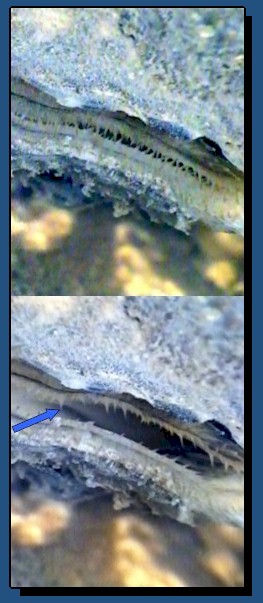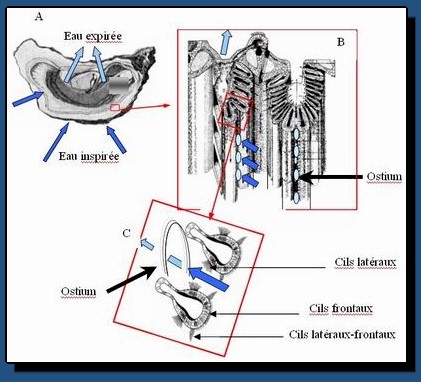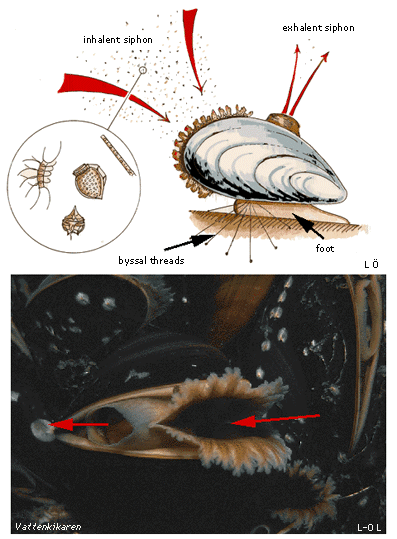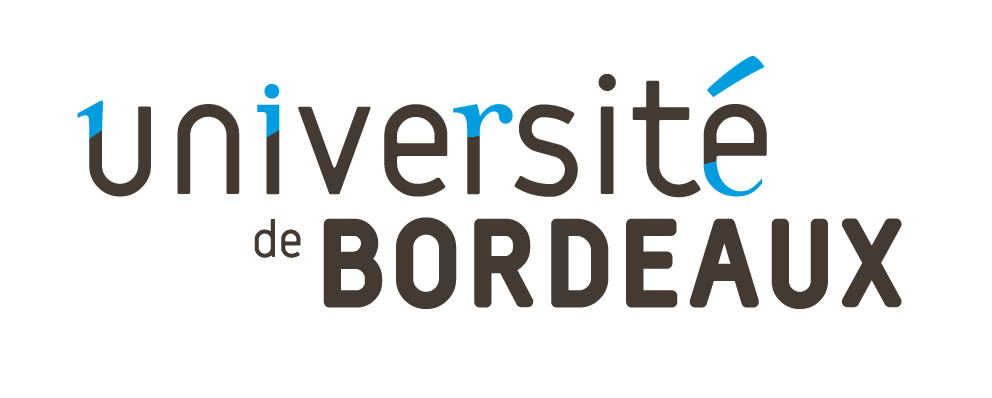

|
Bivale molluscs are "filter feeders" which pump water constantly throughout the day, for two main reasons
To see a remarkable flash animation illustrating how water flows in a bivalve (Authors, A. Richard Palmer & Heather Kroening; Publisher Bio-DiTRL) and two easy reading courses on bivalve physiology (n° 1; n° 2) See another movie about how bivalves feed and how they process the food they ingest ( Prof Evan Ward, University of Connecticut; The Open University). See another one about filter feeding in general (Prof. Mimi Koehl, University of California, Berkeley & The Open University). Towards an internet manual on oyster anatomy and other mollusca (Invertebrate Anatomy OnLine)
Why should we be interested in bivalve molluscs? First, for fundamental research. Although the biology of bivalves is fairly well documented, their physiology and the mechanisms that regulate their pumping activity are still very much a mystery (when they stop and go breathing? [chronobiology], at what rates?). They pump water over their gills, and by ''filtering'' it, they feed and grow, so with a better understanding of how these animals breathe, we will better understand how they live and hence:
|
|
|
The starting point is that bivalve filter feeders are renowned for pumping large quantities of water all day long. However, since the 1980s we have begun to realise that on the contrary very many aquatic animals keep this activity to a minimum, maintaining their blood and cells at as low a level of oxygenation as possible (see note 2 below). This “low oxygenation strategy” also applies to air-breathing animals (insects, rats, mice, humans, etc.), and thus is of wide general interest. However, filtering animals present a specific problem, one that we are currently examining. |
||
|
In order to study bivalve molluscs, a major difficulty is that when the animals are severely disturbed, they have an unfortunate tendency to close themselves up tight … sheltering inside their valves. This is their only natural means of protection against predators. In other situations, they can remain open all the time, pumping water very rapidly for hours. Like all aquatic animals, they are simply very sensitive to many disrupting factors in their environment. So to understand them better, and leave them undisturbed, we have developed the technique, first in the laboratory, then in the field, of non-invasive (or ''non-disturbing'') valvometry (see Home page). Further possible applications in the field. In fact valvometry consists of much more than simply measuring the opening and closing of mollusc valves. As well as recording the states of “open-closed”, it also gives an insight into the behaviour of these animals. Bivalve molluscs have only one (or two) skeletal muscles. So by recording the activity of these muscles we record their entire skeletal muscle activity and open up a fantastic gateway to a study of their activity in different situations (i.e. their ethology). To achieve this, we have to be quite sure that the tools used for analysis do not modify natural behaviour. At the Arcachon Marine Station, our first studies were on animals that measured 1.5-2 cm in length and burrowed freely in sediments. These were Asian clams (Corbicula fluminea), which can be seen on the Home page. It was obviously out of the question to restrain them in any way as we wanted to study them in their natural conditions. This process is ecophysiology. We now use these techniques in the field. They enable us to study animals in their normal and natural conditions. |

|
|
|
As we were not entirely satisfied with any of the commercially available equipment, we developed our own technique using the R & D potential in our own laboratory. Today we have an extremely accurate and reliable piece of electronic equipment. We can also carry out a very large amount of mathematical analysis online, enabling us to quantify behaviour via statistical analyses. These two aspects, combined with a good knowledge of the biology of aquatic organisms, are being developed further by our researchers and engineers at the Arcachon Marine Station. |
||
|
Helping to manage the environment: biosensors As we all know, bivalves pump water all day long. They filter out particles in suspension and constantly “taste” the water by means of their many cells that are chemoreceptive to water quality. Any anomaly that the animal judges to be dangerous can produce a change in behaviour involving for example closure of the valves for varying lengths of time (for self-protection). Death, leaving the valves wide open and immobile, is also an ultimate information for the observer. So the bivalves can help manage their environment, as long as we have the right tools to observe and monitor them (The eye of the mollusc!). This site is a tool for study, for education and management, enabling us to see how the animals behave at a given moment, or after a given event, so that we can understand them better. It is also a tool for continuous water quality monitoring. Internet technology also gives us continuous access from the laboratory, to distant sites and a wide variety of ecosystems where little information is available on the biology of the species found there. We can carry out 24 h / 24 h distance surveillance of ecosystems that are in danger. We are currently working on a project using autonomous buoys which will facilitate this work. |

|
|
|
|
||
|
To find out more: 1 About oxygen. In the laboratory, we have learn that bivalve molluscs, like crustaceans and fish, can regulate ventilation to a minimum, so that blood is oxygenated to a minimum. When there is sufficient plankton in the water, ventilatory activity is inversely proportional to the amount of oxygen in the water (O2 partial pressure): About food. We have also shown the rate of bivalve ventilatory activity can be regulated according to the concentration of plankton in the water. For the animal, the aim is always to try and take in the same quantity of food: a necessary and sufficient amount for its metabolism. When there is less plankton, more water is filtered; when there is more plankton, then less water can be filtered. The lower limits for ventilating are determined by oxygen provision. About biological rhythms: Event when they are fully immersed, bivalves are not permanently open. They exhibit spontaneous periods of closing that are triggered by tidal and circadian rhythms. During spring tides they are opened most of the time (nearly 90%) but during neap tides the daily opening duration decreases down to 55%. Note that when they are closed, their metabolism is 1/10 of the open level. In other words, they are at rest. Sleeping ? That's another story! Tran D, Nadau A, Durrieu G, Ciret P, Parisot JP, Massabuau JC (2011) Field chronobiology in a molluscan bivalve: how the moon and sun cycles interact to drive oyster activity rhythms. Chronobiol. Int. 28: 307-317 Mat AM, Massabuau J-C, Ciret P, Tran D. (2012) Evidence for a plastic dual circadian rhythm in the oyster Crassostrea gigas.Chronobio Inter. 29: 857-867
Reading of general interest for scientists (have a look to our section Bibliography):
|
||





